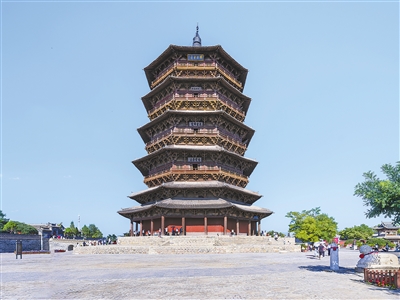
 Intercultural Dialogue Betters the World
Intercultural Dialogue Betters the World World Conference of Classics Explores Ancient Wisdom
World Conference of Classics Explores Ancient Wisdom Joined Without a Single Nail, Surviving Time and Turmoil
Joined Without a Single Nail, Surviving Time and Turmoil Duke Int'l Forum Focuses on Climate Policy, Green Finance
Duke Int'l Forum Focuses on Climate Policy, Green Finance Does Vegetarian Diet Result in Nutrient Deficiency?
Does Vegetarian Diet Result in Nutrient Deficiency? Sustainable Agriculture Across the Pacific Blossoms
Sustainable Agriculture Across the Pacific Blossoms
 |
| The Yingxian Pagoda in Shanxi province. (PHOTO: VCG) |
Mortise and tenon is a type of joint in traditional Chinese woodworking. Widely used in wooden buildings and furniture, this unique construction method developed by China has had a profound impact on traditional wooden construction in East Asia.
The tenon is the protruding part, also known as the groove. The mortise is the concave part, or the tenon eye or tenon groove. The basic principle is to join two components, a mortise is cut in one and a tenon in the other, and then the tenon is inserted into the mortise, interlocking the two parts.
Archaeological discoveries have shown that mortise-and-tenon structures were used as early as 7,000 years ago, both in the wooden buildings preserved at the Hemudu site, a Neolithic cultural site in Zhejiang province in east China, and in wooden items such as utensil handles and small rods.
Hundreds of wooden components from the Hemudu site have different types of tenons. In the thousands of years that followed, mortise and tenon construction continued to improve, reaching its peak in ancient China. The Foguang Temple, a Buddhist shrine that is regarded as China's second oldest surviving wooden structure, built around 857 AD in the Tang Dynasty and now a UNESCO World Heritage, and the Yingxian Wooden Pagoda in Yingxian county, in Shanxi province, built in 1056 AD during the Liao Dynasty, are typical examples of mortise and tenon architecture.
The Yingxian Wooden Pagoda is the tallest surviving ancient wooden structure in the world at 67.31 meters. The main body of the tower is made up of tens of thousands of wooden components and has been standing for more than 900 years despite many earthquakes, thanks in large part to the mortise and tenon construction.
Displacement, or leaving a slight gap, is the main advantage of mortise and tenon construction. The components are flexibly joined. There is a minute gap between the tenon and the mortise, leaving room for expansion and contraction of the wood during different weathers, thereby improving the building's ability to withstand earthquakes.
The joining technique using mortise and tenon has deep cultural connotation besides efficiency as a cultural, scientific and innovative characteristic of one of China's traditional crafts.






